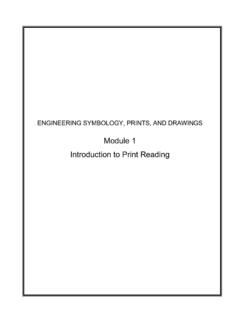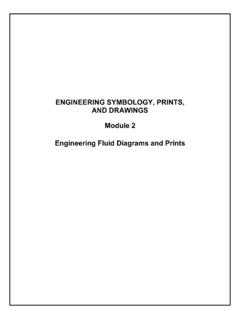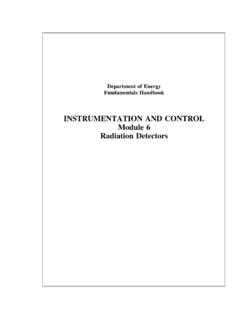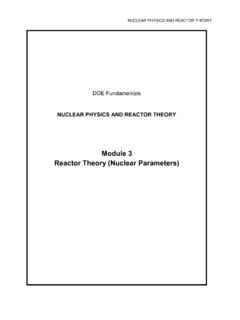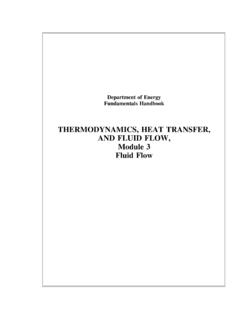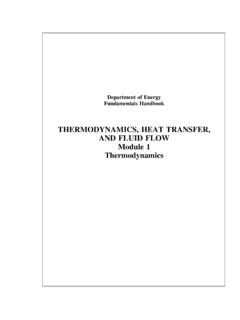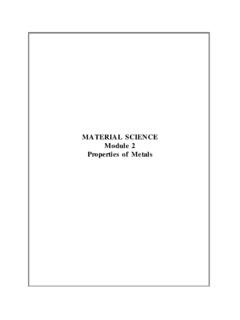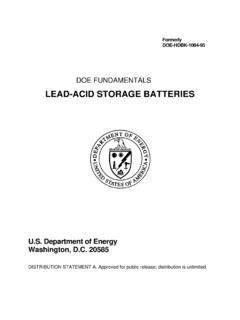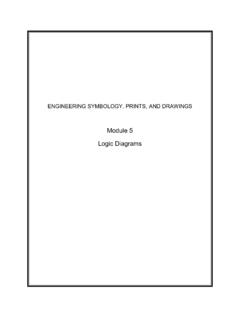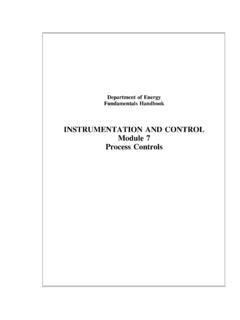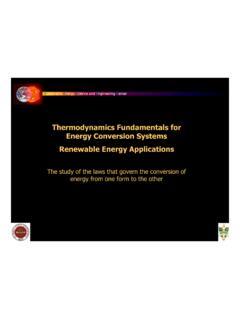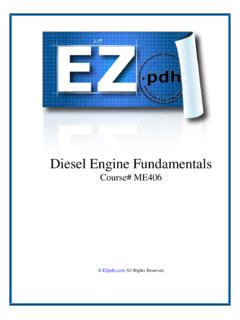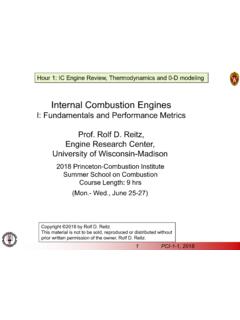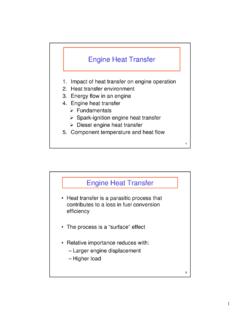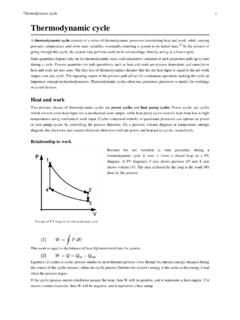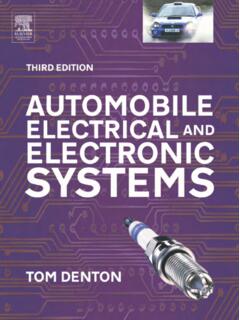Transcription of Diesel Engine Fundamentals - Energy
1 DOE Fundamentals MECHANICAL SCIENCE Module 1 Diesel Engine Fundamentals Mechanical Science Diesel Engine Fundamentals MS-01-ii TABLE OF CONTENTS TABLE OF CONTENTS .. ii LIST OF FIGURES .. iv LIST OF TABLES .. vi REFERENCES .. vii OBJECTIVES .. viii Diesel ENGINES .. 1 Introduction .. 1 History .. 2 Diesel Engines .. 2 Major Components of a Diesel 3 The Cylinder Block .. 5 Crankcase and Oil Pan .. 6 Cylinder Sleeve or Bore .. 6 Piston and Piston Rings .. 7 Connecting Rod .. 7 Crankshaft .. 7 Flywheel .. 8 Cylinder Heads and Valves .. 9 Timing Gears, Camshaft, and Valve Mechanism .. 9 Blower ..11 Diesel Engine Support Systems ..11 Exhaust System ..15 Operational Terminology ..15 Bore and Stroke ..15 Summary ..17 Fundamentals OF THE Diesel CYCLE ..18 The Basic Diesel Cycles ..18 The Four-Stoke Cycle ..19 The Two-Stroke Cycle ..22 Summary ..24 Mechanical Science Diesel Engine Fundamentals MS-01-iii Diesel Engine SPEED, FUEL CONTROLS, AND PROTECTION ..26 Engine Control ..26 Fuel Injectors.
2 26 Governor ..29 Operation of a Governor ..30 Starting Circuits ..32 Engine Protection ..33 Summary ..35 Mechanical Science Diesel Engine Fundamentals MS-01-iv LIST OF FIGURES Figure 1 Example of a Large Skid-Mounted, Diesel -Driven Generator .. 2 Figure 2 Cutaway of a Four-Stroke Supercharged Diesel Engine .. 4 Figure 3 Cross Section of a V-type Four Stroke Diesel Engine .. 5 Figure 4 The Cylinder Block .. 5 Figure 5 Diesel Engine Wet Cylinder Sleeve .. 6 Figure 6 Piston and Piston Rod .. 7 Figure 7 Diesel Engine Crankshaft and Bearings .. 8 Figure 8 Diesel Engine Valve .. 9 Figure 9 Diesel Engine Camshaft and Drive Gear .. 9 Figure 10 Diesel Engine Valve Train .. 10 Figure 11 Diesel Engine Cooling System .. 11 Figure 12 Diesel Engine Internal Lubrication System .. 12 Figure 13 Diesel Engine Fuel Flowpath .. 13 Figure 14 Oil Bath Air Filter .. 14 Figure 15 Compression Ratio .. 16 Figure 16 Scavenging and Intake .. 19 Figure 17 Compression .. 20 Figure 18 Fuel Injection.
3 20 Figure 19 Power .. 21 Figure 20 Exhaust .. 21 Figure 21 2-Stroke Exhaust .. 22 Figure 22 2-Stroke Intake .. 22 Figure 23 2-Stroke Compression .. 23 Figure 24 2-Stroke Fuel Injection .. 23 Figure 25 2-Stroke Power .. 23 Mechanical Science Diesel Engine Fundamentals MS-01-v Figure 26 Fuel Injector Cutaway .. 27 Figure 27 Fuel Injector Plunger .. 28 Figure 28 Simplified Mechanical-Hydraulic Governor .. 30 Figure 29 Cutaway of a Woodward Governor .. 31 Mechanical Science Diesel Engine Fundamentals MS-01-vi LIST OF TABLES NONE Mechanical Science Diesel Engine Fundamentals MS-01-vii REFERENCES Benson & Whitehouse, Internal Combustion Engines, Pergamon. Cheremisinoff, N. P., Fluid Flow, Pumps, Pipes and Channels, Ann Arbor Science. Scheel, Gas and Air Compression Machinery, McGraw/Hill. Skrotzki and Vopat, Steam and Gas Turbines, McGraw/Hill. Stinson, Karl W., Diesel Engineering Handbook, Diesel Publications Incorporated. Mechanical Science Diesel Engine Fundamentals MS-01-viii OBJECTIVES TERMINAL OBJECTIVE Without references, DESCRIBE the components and theory of operation for a Diesel Engine .
4 ENABLING OBJECTIVES DEFINE the following Diesel Engine terms: a. Compression ratio b. Bore c. Stroke d. Combustion chamber Given a drawing of a Diesel Engine , IDENTIFY the following: a. Piston/rod e. Intake ports or valve(s) b. Cylinder f. Exhaust ports or valve(s) c. Blower g. Fuel injector d. Crankshaft EXPLAIN how a Diesel Engine converts the chemical Energy stored in the Diesel fuel into mechanical Energy . EXPLAIN how the ignition process occurs in a Diesel Engine . EXPLAIN the operation of a 4-cycle Diesel Engine to include when the following events occur during a cycle: a. Intake d. Compression b. Exhaust e. Power c. Fuel injection EXPLAIN the operation of a 2-cycle Diesel Engine , including when the following events occur during a cycle: a. Intake d. Compression b. Exhaust e. Power c. Fuel injection DESCRIBE how the mechanical-hydraulic governor on a Diesel Engine controls Engine speed. LIST five protective alarms usually found on mid-sized and larger Diesel engines.
5 Mechanical Science Diesel Engine Fundamentals MS-01-1 Diesel ENGINES One of the most common prime movers is the Diesel Engine . Before gaining an understanding of how the Engine operates a basic understanding of the Engine 's components should be gained. This chapter reviews the major components of a generic Diesel Engine . EO DEFINE the following Diesel Engine terms: a. Compression ratio b. Bore c. Stroke d. Combustion chamber EO Given a drawing of a Diesel Engine , IDENTIFY the following: a. Piston/rod e. Intake ports or valve(s) b. Cylinder f. Exhaust ports or valve(s) c. Blower g. Fuel injector d. Crankshaft Introduction Most DOE facilities require some type of prime mover to supply mechanical power for pumping, electrical power generation, operation of heavy equipment, and to act as a backup electrical generator for emergency use during the loss of the normal power source. Although several types of prime movers are available (gasoline engines, steam and gas turbines), the Diesel Engine is the most commonly used.
6 Diesel engines provide a self-reliant Energy source that is available in sizes from a few horsepower to 10,000 hp. Figure 1 provides an illustration of a common skid-mounted, Diesel -driven generator. Relatively speaking, Diesel engines are small, inexpensive, powerful, fuel efficient, and extremely reliable if maintained properly. Because of the widespread use of Diesel engines at DOE facilities, a basic understanding of the operation of a Diesel Engine will help ensure they are operated and maintained properly. Due to the large variety of sizes, brands, and types of engines in service, this module is intended to provide the Fundamentals and theory of operation of a Diesel Engine . Specific information on a particular Engine should be obtained from the vendor's manual. Mechanical Science Diesel Engine Fundamentals MS-01-2 Figure 1 Example of a Large Skid-Mounted, Diesel -Driven Generator History The modern Diesel Engine came about as the result of the internal combustion principles first proposed by Sadi Carnot in the early 19th century.
7 Dr. Rudolf Diesel applied Sadi Carnot's principles into a patented cycle or method of combustion that has become known as the " Diesel " cycle. His patented Engine operated when the heat generated during the compression of the air fuel charge caused ignition of the mixture, which then expanded at a constant pressure during the full power stroke of the Engine . Dr. Diesel 's first Engine ran on coal dust and used a compression pressure of 1500 psi to increase its theoretical efficiency. Also, his first Engine did not have provisions for any type of cooling system. Consequently, between the extreme pressure and the lack of cooling, the Engine exploded and almost killed its inventor. After recovering from his injuries, Diesel tried again using oil as the fuel, adding a cooling water jacket around the cylinder, and lowering the compression pressure to approximately 550 psi. This combination eventually proved successful. Production rights to the Engine were sold to Adolphus Bush, who built the first Diesel engines for commercial use, installing them in his St.
8 Louis brewery to drive various pumps. Diesel Engines A Diesel Engine is similar to the gasoline Engine used in most cars. Both engines are internal combustion engines, meaning they burn the fuel-air mixture within the cylinders. Both are reciprocating engines, being driven by pistons moving laterally in two directions. The majority of their parts are similar. Although a Diesel Engine and gasoline Engine operate with similar components, a Diesel Engine , when compared to a gasoline Engine of equal horsepower, is heavier due to stronger, heavier materials used to withstand the greater dynamic forces from the higher combustion pressures present in the Diesel Engine . Mechanical Science Diesel Engine Fundamentals MS-01-3 The greater combustion pressure is the result of the higher compression ratio used by Diesel engines. The compression ratio is a measure of how much the Engine compresses the gasses in the Engine 's cylinder. In a gasoline Engine the compression ratio (which controls the compression temperature) is limited by the air-fuel mixture entering the cylinders.
9 The lower ignition temperature of gasoline will cause it to ignite (burn) at a compression ratio of less than 10:1. The average car has a 7:1 compression ratio. In a Diesel Engine , compression ratios ranging from 14:1 to as high as 24:1 are commonly used. The higher compression ratios are possible because only air is compressed, and then the fuel is injected. This is one of the factors that allows the Diesel Engine to be so efficient. Compression ratio will be discussed in greater detail later in this module. Another difference between a gasoline Engine and a Diesel Engine is the manner in which Engine speed is controlled. In any Engine , speed (or power) is a direct function of the amount of fuel burned in the cylinders. Gasoline engines are self-speed-limiting, due to the method the Engine uses to control the amount of air entering the Engine . Engine speed is indirectly controlled by the butterfly valve in the carburetor. The butterfly valve in a carburetor limits the amount of air entering the Engine .
10 In a carburetor, the rate of air flow dictates the amount of gasoline that will be mixed with the air. Limiting the amount of air entering the Engine limits the amount of fuel entering the Engine , and, therefore, limits the speed of the Engine . By limiting the amount of air entering the Engine , adding more fuel does not increase Engine speed beyond the point where the fuel burns 100% of the available air (oxygen). Diesel engines are not self-speed-limiting because the air (oxygen) entering the Engine is always the maximum amount. Therefore, the Engine speed is limited solely by the amount of fuel injected into the Engine cylinders. Therefore, the Engine always has sufficient oxygen to burn and the Engine will attempt to accelerate to meet the new fuel injection rate. Because of this, a manual fuel control is not possible because these engines, in an unloaded condition, can accelerate at a rate of more than 2000 revolutions per second. Diesel engines require a speed limiter, commonly called the governor, to control the amount of fuel being injected into the Engine .
